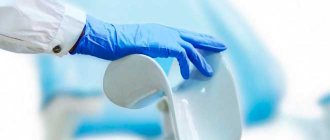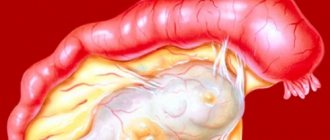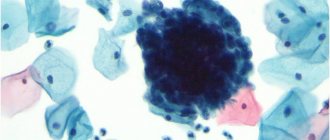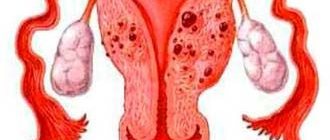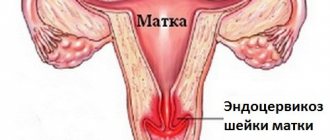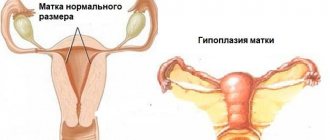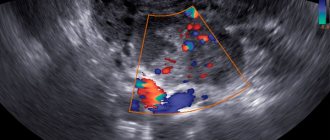What is chronic adnexitis
Chronic adnexitis is an inflammatory process that occurs in the fallopian tubes and ovaries.
Symptoms of the disease appear depending on:
- From the general state of health - the disease occurs when the immune system is weakened.
- Location of the source of inflammation.
There is a deterioration in the woman’s well-being; body temperature can rise to 40 degrees. The patient is bothered by severe nagging pain in the lower abdomen, abundant mucous-purulent discharge appears, leading to inflammation of the skin in the perineal area.
The woman becomes nervous and irritable. Against this background, insomnia may develop, and as a result, a depressive state. Moreover, periods of calm are replaced by a relapse of symptoms of the disease.
Definition
Left-sided adnexitis refers to inflammation of the ovaries or fallopian tubes located on the left side. Usually pathological processes affect both organs or just the tube, but one ovary is rare.
Due to the structural features of the female body, adnexitis is most often found on the left. But the right side is not insured, so there is no need to let down your vigilance. At an appointment with a gynecologist, having heard about the diagnosis, a woman immediately wants to know what left-sided adnexitis is and how to treat it, how dangerous it is for the reproductive system.
https://youtu.be/Um0coGEDnlw
Causes of pathology
Treatment is based on identifying the cause that led to the development of adnexitis. The causative agents of the disease include: Staphylococcus aureus, chlamydia, gonococci, enterococci and other pathogenic bacteria.
Many of these bacteria are present in a healthy body and do not manifest themselves in any way. Under negative factors, pathogenic microorganisms begin to actively multiply, causing inflammation.
Adnexitis - what is it in women?
Adnexitis, or salpingoophoritis, is an inflammation of the uterine appendages (ovaries, fallopian tubes and ligaments). The disease can be acute or chronic, occurring on one or both sides of the uterus.
In adnexitis, pathogenic bacteria invade the mucous membrane of the fallopian tube, involving the muscular and serous layers of the organ in the inflammatory process. Next, the inflammation spreads to the peritoneum of the pelvis and moves to the ovaries. The infection penetrates directly into the ovary after ovulation, entering through the corpus luteum or a burst follicle.
Extensive inflammation during adnexitis contributes to the formation of a conglomerate from the ovary and fallopian tube, which subsequently leads to the formation of a tubo-ovarian abscess. The patency of the fallopian tubes as a result of adnexitis is sharply reduced due to the formation of numerous adhesions and cords. The outcome of the acute form of the disease can be rupture of the tubo-ovarian abscess.
Dangerous complications in chronic inflammation of the appendages:
- Attachment of anaerobic infection;
- Development of sepsis,
- Perforation of the peritoneum.
Chronitization of adnexitis occurs as a result of incorrectly chosen tactics for treating acute salpingoophoritis. Characteristic features of the chronic form of the disease are a sluggish course with periodic exacerbations, the need for more complex and lengthy treatment.
According to ICD-10, the chronic form of the disease has code N70.1 (chronic salpingitis and oophoritis).
What triggers the development of the disease
Chronic inflammation of the appendages is provoked by the following factors:
- Lack of contraception, which increases the risk of contracting diseases transmitted through sexual contact.
- Insufficient personal hygiene.
- General hypothermia of the body.
- Complications during the postpartum period.
- Abortion.
- Installation or removal of the intrauterine device.
- Violations during gynecological operations performed previously.
- Predisposition to constipation.
Types of adnexitis
According to symptoms, the disease is divided into two types:
- Acute adnexitis.
- Chronic adnexitis.
According to the nature of the lesion, they are distinguished:
- right-sided;
- left-handed;
- bilateral.
With right-sided and left-sided inflammation, the source of pain is localized on the corresponding side. If unilateral inflammation is not detected in time and treatment is not started, bilateral adnexitis forms, which implies pain throughout the lower abdomen. The pain intensifies with hypothermia and sexual contact.
With bilateral salpingo-oophoritis, adhesive manifestations occur, which often causes infertility in the patient. As a result of the occurrence of adhesions, an accumulation of pus is formed, after which sepsis develops. Then it becomes necessary to remove the body of the uterus along with the appendages.
How does it manifest?
The clinical picture of the disease depends not only on the nature of the inflammation (acute, subacute or chronic), but also on whether the pathological process is unilateral or bilateral. In order to see a doctor in time, every woman should know how adnexitis can manifest itself. Symptoms and treatment of inflammation of the uterine appendages are interconnected links in one chain.
Acute course
An acute inflammatory process in the ovaries and fallopian tubes is characterized by a sharp onset. Based on typical complaints, you can immediately suspect a problem with the uterine appendages. With acute adnexitis, women will experience the following symptoms and signs:
- Body temperature rises to febrile levels of 38–38.5 °C.
- Chills.
- Headache.
- Increased sweating.
- Fast fatiguability.
- Pain in the lower abdomen.
- The abdominal muscles are tense.
- Painful sensations during intimacy.
- Possible menstrual irregularities.
- Various types of vaginal discharge.
- Problems with urination.
I would like to clarify that with acute left-sided adnexitis, pain will be observed in the lower abdomen on the left, and with right-sided adnexitis, pain will be observed on the right. In the case of a bilateral inflammatory process, painful sensations spread over the entire surface of the lower abdomen without clear localization in a specific area.
In addition, serous, mucopurulent or purulent discharge from the vagina often appears with acute adnexitis.
Subacute course
Some women do not quite understand exactly what “subacute adnexitis” is and how it can affect their health. The main feature of subacute adnexitis is that it is characterized by all clinical symptoms and signs, but they are only less pronounced than in acute inflammation of the ovaries and fallopian tubes. If timely treatment is not carried out, the diagnosis often changes to chronic adnexitis. And this can provoke further development of infertility or pathological pregnancy.
If the cause of adnexitis is a sexually transmitted infection, then when formulating the diagnosis, indicate the type of pathogen (chlamydia, gonococci, etc.).
Chronic course
As with the acute course of the disease, chronic adnexitis can be left-sided, right-sided or bilateral. Among the clinical symptoms of chronic adnexitis, it is worth noting aching, pulling, painful sensations in the lower abdomen. The pain may radiate to the groin area and vagina. However, their intensity is not as pronounced as in acute or subacute inflammation of the ovaries and fallopian tubes.
By the location of the pain, you can determine which uterine appendage is involved in the pathological process. If painful sensations are noted in the left side, then this is left-sided salpingoophoritis. If it’s on the right side, then it’s right-sided. However, if the pain affects the entire lower abdomen, then, most likely, chronic bilateral salpingophritis or adnexitis has developed. In addition to pain, the following clinical signs are typical for chronic inflammation of the uterine appendages:
- Menstrual irregularities.
- Painful, heavy, irregular periods.
- Some women, on the contrary, experience very scanty periods and menstruation lasts less than a period.
- Discharges of various types (mucopurulent, purulent, mixed with blood, etc.).
- Decreased sexual desire.
- Unpleasant sensations and discomfort during intimacy.
- Infertility.
- Malfunctions of the intestines and urinary system.
From time to time, an exacerbation of chronic adnexitis may occur, which is provoked by banal hypothermia, overwork, stress, poor nutrition and other factors.
Symptoms of manifestation
Chronic adnexitis is the most common disease of the female organs. This form of inflammation has less severe symptoms.
Symptoms characteristic of chronic oophoritis:
- The occurrence of aching pain in the perineal area.
- Increased body temperature.
- Chills.
- Sharp pain during urination.
- Change in the amount of menstrual flow.
- Increased purulent vaginal discharge.
- Irritability and nervousness.
In the chronic course of the disease, pain intensifies before the onset of menstruation. There is also bloating in the abdomen, and the discharge itself becomes scanty or stops altogether.
Prevention
Chronic adnexitis is a very serious disease that often causes infertility. To avoid tubal infertility and problems with ovulation, you need to do your best to avoid the occurrence of chronic adnexitis and its exacerbation. To do this, the following preventive measures must be observed:
- Treat all infectious and inflammatory diseases in a timely manner under the supervision of a doctor, never self-medicate, even with acute respiratory infections.
- If you experience abdominal pain, menstrual irregularities, or changes in discharge, you should immediately be examined by a gynecologist.
- Every 6 months you need to be examined by a gynecologist, even if nothing hurts. This applies to all women, starting from puberty, that is, from 11-13 years old until the end of life.
- Try to strengthen your immune system: harden yourself, eat a balanced diet, take vitamins.
- Avoid a passive lifestyle, do exercises, play sports.
- Maintain a work-rest schedule, get enough sleep, and avoid stress.
- Lead a healthy sex life, protect yourself from STIs and unwanted pregnancies, and avoid frequent changes of sexual partners.
Only the right attitude towards your health will help you avoid chronic adnexitis and other serious diseases of the reproductive system.
Treatment of chronic adnexitis
The treatment plan is prescribed by the doctor based on a general examination of the patient and consideration of all existing symptoms. Laboratory tests are also prescribed to help identify the cause of inflammation and the causative agent of infection.
After studying the test results, a treatment regimen is developed and the dosage of medications is established, which are prescribed by a specialist individually for each patient. If the course of medication is not followed, complications arise, which can lead to longer treatment.
Antibiotics
The following drugs are used to treat salpingoophoritis:
- Erythromycin is a strong antibiotic administered into the body through a dropper.
- Metronizadol – administered intravenously.
- Cevtibuten is a strong antibacterial drug. Taken orally.
Vitamin complexes
Drug treatment includes antibiotics, antipyretics and painkillers. Quite often, treatment with these drugs is enhanced with vitamin complexes, which help to localize foci of inflammation in the shortest possible time and strengthen the body’s immune forces. Vitamins B, C and E are used.
- Vitamin C – ascorbic acid. Prevents the development of pathogenic bacteria, strengthens the immune system.
- Vitamin E – reduces inflammation, has a beneficial effect on the resorption of adhesive manifestations, and accelerates the process of cell restoration.
- Vitamin B – strengthens the body’s immune forces, fights infections, improves metabolic processes in tissues.
Most often, combination treatment is used, which includes several medications at once, which enhances their effect.
Douching
During the procedure, pathogenic microflora is washed out of the vagina. Douching is carried out with chloride-sodium and sulfide-containing agents, as well as decoctions of chamomile, celandine and calendula.
The most convenient way to douche is in the bath, taking a comfortable position. It is necessary to relax the pelvic muscles, insert the tip of the rubber bulb into the vagina and inject the solution by pressing the balloon, then stay at rest for five minutes.
Usually a course lasting from one to two weeks is prescribed.
Physiotherapeutic procedures
After physiotherapeutic treatment, there is a decrease in pain symptoms and cell regeneration occurs.
Procedures performed:
- Electrophoresis - electrical impulses are applied using zinc, magnesium and potassium.
- Magnetotherapy is exposure to a low-frequency magnetic field.
- Vibromassage – improves blood circulation.
In a state of stable remission of the disease, resort and sanatorium treatment is recommended to consolidate positive results.
Causes
Left-sided adnexitis - we have already found out what it is. Now it’s time to find out the causes of inflammation, since this disease is famous for its rapid development. The reasons are listed below:
- Sexual intercourse. Like any other inflammatory diseases, adnexitis is caused by bacteria and microbes entering the body, for example, during unprotected sex with a casual partner, or with frequent changes of men.
- Hypothermia provokes vasospasm, which prevents immune cells from being transported to the site of infection. This condition often becomes a provoking factor when an inflammatory process occurs.
- Abortion. Termination of pregnancy increases the risk of pelvic infection.
- Hygiene. If a woman doesn’t take good care of her body and rarely washes herself, then there is also a chance that the infection will spread inside the body, causing acute left-sided adnexitis.
- Childbirth. During labor, the cervix is wide open and bacteria can get inside, causing inflammation.
- Infectious diseases. It happens that completely unrelated diseases complicate each other. So, with a sore throat or pyelonephritis, if the patient does not follow the specialist’s instructions, the bacteria begin to uncontrollably infect other organs, including the ovaries.
Many people know what it is and for what reasons it occurs: Left-sided adnexitis. But still, the growth of the disease is constantly increasing. Therefore, you need to be careful about the prevention of inflammatory processes in the reproductive system.
Treatment of chronic adnexitis at home
After examination by a gynecologist, treatment at home may be prescribed, but only if there are no acute manifestations of adnexitis.
Treatment is carried out with the help of suppositories, by inserting them into the vagina and using traditional medicine.
Vaginal suppositories have a direct effect on the source of inflammation. Most often used:
- Polygynax - fights pathogenic pathogens.
- Hexicon - effectively reduces inflammation in the ovaries.
- Betadine – has antimicrobial properties.
For home treatment, decoctions and infusions of medicinal herbs are used.
Herbal infusion recipes
- In a clean bowl, combine 200 grams of oregano, the same amount of oak bark and add 100 grams of marshmallow root. Mix everything thoroughly. Five st. Brew a tablespoon of the prepared mixture with boiling water. Wrap the dish in a towel and let it sit for an hour. After cooling completely, strain the infusion and use for douching.
- Mix finely ground flowers of yellow sweet clover and centaury - 150 grams of each. Take half of the resulting mixture and brew it with one liter of boiling water. Leave the mixture for forty to fifty minutes. It is necessary to take the product for a month, half a glass five times a day.
- Mix the herbal mixture: St. John's wort, nettle and yarrow leaves - 100 grams each. Add here 150 grams of coltsfoot flowers, marshmallow root and gabrets. Mix everything thoroughly and brew with one liter of boiling water. Infuse the decoction for two hours. Dose: half a glass before meals for one and a half months.
Also, when treating chronic adnexitis at home, mumiyo and propolis are used. Moreover, both of these drugs can be taken simultaneously. Shilajit is taken twice a day half an hour before meals, and alcohol-based propolis is taken a few drops with food.
Drug treatment
Acute left-sided adnexitis is treated in a hospital; the patient is prescribed bed rest, strict adherence to a diet, drinking plenty of fluids (teas, infusions, milk and fruit drinks), while monitoring the urinary system. The drugs of choice for this disease are: analgesic, desensitizing, antispasmodic medicine. Broad-spectrum antibiotics play the main role in the treatment of left-sided adnexitis. Upon admission to the hospital, the patient is given a loading dose for 3 days. After obtaining a positive recovery trend, they switch to the average therapeutic dosage.
The development of sepsis complicates the treatment of the disease. In this case, antibiotic therapy is combined with bactericidal agents. To relieve intoxication syndrome, infusion solutions are used. For purulent lesions, the method of laparoscopy and subsequent treatment of inflammation with antiseptics in combination with antibiotics are used. In particularly difficult cases, they resort to surgical intervention, removing the affected organs and tissues.
Preventive measures
To prevent the occurrence of adnexitis and further complications caused by this disease, it is necessary to take preventive measures and follow some rules:
- avoid casual sex;
- use barrier contraception (condoms);
- prevent hypothermia of the body;
- try to avoid stressful situations;
- take vitamin complexes to maintain immunity;
- eliminate bad habits - alcohol and smoking;
- prevent the occurrence of sexually transmitted infections;
- balance nutrition;
- carry out general strengthening procedures - hardening, engage in active sports.
- Visit your gynecologist regularly.
Adnexitis that is not fully treated is dangerous due to its complications, including the development of infertility. For a complete recovery, you must strictly follow the course of treatment and follow all the recommendations prescribed by the specialist.
If you find a typo or inaccuracy, please select a piece of text and press Ctrl+Enter.
Left-sided adnexitis: signs, diagnosis and treatment of different forms of the disease
Quite often, girls and women have problems related to the reproductive organs. One of the common diseases, which is diagnosed mainly in representatives of the fair half of humanity aged 20 to 30 years, is adnexitis, which can be left-sided or right-sided.
What is left-sided adnexitis
Left-sided adnexitis - description of the disease
Due to strange circumstances, for some reason doctors most often diagnose left-sided adnexitis, although this cannot be explained in any way.
Left-sided adnexitis is inflammation of the fallopian tubes or ovaries on the left side. Everyone knows that the ovaries are located both on the right and on the left. Therefore, both inflammations are dangerous.
The symptoms of the problem are very obvious, and often a woman, going to the gynecologist, already approximately knows her diagnosis. Of course, hearing it for the first time, everyone gets scared, because, as you know, one of the most common complications regarding problems with the reproductive system is infertility.
Therefore, when the very first and sometimes not the most obvious symptoms appear, it is necessary to visit a gynecologist, because only during the examination will he be able to make an accurate diagnosis and understand the stage of the inflammatory process, because the speed of recovery will depend on this, as well as the possibility of pregnancy in the future.
The second name for the disease, and a fairly common one, is salpingoophoritis.
True, not all doctors pronounce this particular term out loud in front of patients, because due to the large number of letters and the incomprehensible combination of several Latin words, it terrifies patients. Therefore, it is customary to use adnexitis. Although they mean the same thing.
If we talk about deciphering the term “salpingoophoritis”, then we must say that salpingitis means an inflammatory process in the fallopian tubes, and oophoritis - in the ovaries. Therefore, when there is inflammation of the tubes and ovaries, the term adnexitis is used.
All gynecologists say the same thing: improper treatment and ignoring problems associated with inflammation of the fallopian tubes and ovaries in the future leads to serious obstetric problems, which are often simply impossible to solve due to the advanced state of the disease.
Causes of adnexitis
The most common causes of the disease
Due to the fact that the disease develops very quickly, it is important to say for what reasons it may begin to develop. Salpingo-oophoritis develops when microbes and bacteria enter the body, which provoke serious inflammation, often very dangerous.
Microbes and bacteria entering the female body can provoke an inflammatory process in the following conditions:
- If a woman has contracted any infection from her sexual partner. This occurs during unprotected sexual intercourse and with frequent changes of partners, especially when the relationships are casual.
- If a woman has been in cold water for a long time, which often happens either in the summer months while swimming in reservoirs, or vice versa, in winter. Due to the fact that the majority of female representatives prefer to spend their free time in gyms, namely, swimming in pools, where the water, although of normal temperature, can cause hypothermia, taking into account individual characteristics.
- If a woman was in the cold for a long time, did not dress for the weather, or sat on a cold floor or concrete.
- If the woman had an abortion. When this manipulation is not performed in a specialized clinic or hospital, the likelihood of infections increases, and as a result, the development of complications in the form of adnexitis.
- If a woman has given birth. Quite often during childbirth, if instruments are poorly sterilized, as well as basic hygiene rules are not followed, an infection can get into the fallopian tubes and ovaries.
- If personal hygiene rules are not followed. This includes not only intimate hygiene, but also simple washing of hands, face, etc.
Useful information from the video about adnexitis.
In addition, adnexitis can appear as a complication after infectious diseases such as tonsillitis, tonsillitis, pyelonephritis, when improper treatment and non-compliance with specialist recommendations increases the likelihood of the infection spreading further throughout the organs. And the weak point of any woman is her reproductive organs
Despite the fact that almost everyone knows for what reasons adnexitis can develop, few people take it upon themselves and try to take preventive measures.
Because of this, every year specialists are increasingly diagnosing “salpingo-oophoritis”.
Symptoms of left-sided adnexitis
Symptoms of the disease
The symptoms of the disease are obvious, so few people can ignore them. If we are talking about left-sided adnexitis, then all of them will predominantly manifest themselves on their side, the exception, of course, is the pain being transmitted to another place.
So, the main symptoms of left-sided adnexitis include:
- Slight pain in the lower abdomen. Some women note that it seems to be pulsating below. The pain seems to be felt, but does not cause visible discomfort. Doctors say this manifestation is called the subacute stage.
- Painful sensations during sexual intercourse.
- Painful sensations during bowel movements, as well as when walking quickly. It is these symptoms that make a girl think about existing problems, since if they can attribute pain during sexual intercourse to intensity, in this case it is very difficult to attribute it to anything.
- Acute pain that will radiate to the sacral area. Moreover, such attacks are short-lived and pass quickly.
- Increased body temperature. This symptom does not appear in all women, since each body is individual.
- An increase in vaginal discharge, which becomes much more numerous than before and its amount does not correspond to the phase of the cycle.
During the acute stage, which occurs most often, the pain can become so severe that only lying down can be tolerated. In addition, the accumulation of pus that appears in the advanced stage leads to a significant increase in body temperature. Sometimes above 39 degrees, and there is a danger of inflammation of the entire abdominal cavity.
Chronic left-sided adnexitis
And if with the acute stage of the disease everything is more or less clear, since the symptoms are so obvious that you have to turn to specialists, then with regard to the chronic form everything is more complicated. It is not so obvious, and only a gynecologist can pay attention to it during the next preventive examination.
Symptoms of chronic left-sided adnexitis include:
- Painful sensations in the abdominal area, which periodically radiate to the lower back. The pain is not severe, just a little discomfort.
- Pain during menstruation. Many doctors believe that if everything is in order in the body of a girl or woman, then during menstruation pain can appear only on the first day, and even then not severely. If the fallopian tubes and ovaries are inflamed, then during menstruation the pain will be almost unbearable. Patients note that even painkillers do not always help. And some even lose consciousness, the pain is so severe.
- Pain during sexual intercourse. Women note that during sexual intercourse they feel pain, especially almost at the very end. Because of this, some people refuse sex altogether, because it’s not that it doesn’t bring any pleasure, but sometimes the pain becomes unbearable.
- General malaise, which manifests itself as constant fatigue, sometimes depression.
The danger of chronic left-sided adnexitis is that due to the peculiarity of the manifestation of symptoms, not everyone immediately consults a doctor. Meanwhile, the disease can gradually destroy the body and ultimately lead to infertility.
With adnexitis, adhesions form, which can cause the symptoms described above.
Moreover, adhesions can penetrate into the fallopian tubes, causing infertility, which is difficult and almost impossible to cure.
Diagnosis of the disease
Methods for detecting the disease
After a woman has the first symptoms and she decides to see a specialist, he will have to conduct a full examination and take all the necessary tests to make an accurate diagnosis.
In order for the doctor to make a correct diagnosis, it will be necessary to carry out the following manipulations:
- Taking blood for general and biochemical tests, which will show whether there is a focus of inflammation or not.
- An ultrasound examination of the pelvic organs, during which you can see whether there is inflammation and how severe it is.
- Examination by a gynecologist on a gynecological chair.
- Taking a smear from the vagina and a scraping of the cervix.
Sometimes, to rule out diseases such as tuberculosis and pneumonia, the doctor may prescribe an x-ray.
Only after receiving all the results of the studies can the doctor make a final diagnosis and proceed to prescribing the necessary drugs to treat the disease.
Treatment of the chronic form
It is very important to choose the right treatment for the chronic form of adnexitis, since the disease in this case is much more dangerous due to the hidden symptoms.
Chronic left-sided adnexitis is treated as follows:
- Anti-inflammatory drugs are prescribed, and very strong ones. The main part is applied intravaginally to achieve the goal as quickly as possible.
- Antihistamines are prescribed, which reduce the possible reaction to a particular drug, and also reduce swelling.
- Prescribing painkillers to help reduce pain. Most often, weak drugs are prescribed, since the pain in the chronic course of the disease is not severe and occurs only during sexual intercourse or heavy physical exertion.
- Prescribing vitamin complexes to restore the body and replenish the lack of vitamins and minerals.
- Immunomodulators are prescribed to help improve immunity, since chronic diseases are often caused by a weak immune system and the inability of the body to resist bacteria and microbes that penetrate it.
- Intravaginal administration of special drugs is prescribed that will locally affect the source of inflammation. It is noted that they are able to quickly reduce pain and relieve inflammation.
- In addition, during the treatment of the chronic stage, women are prescribed physiotherapy sessions, which in no case should be refused.
Another recommendation during the treatment of salpingo-oophoritis (especially chronic) is a gynecological massage to relax the muscles, but at the same time restore the tone of the walls of the uterus and fallopian tubes.
Left-sided adnexitis is very dangerous, because if the acute stage is not treated in time, it easily becomes chronic.
And the chronic course of the disease can lead to the development of complications, the most dangerous and serious of which is infertility. Therefore, when the very first symptoms appear, you should consult a specialist for advice.
Source: https://DiagnozLab.com/analysis/infectious/urogenital/levostoronnij-adneksit-priznaki-diagnostika-i-lechenie-raznyh-form-bolezni.html
